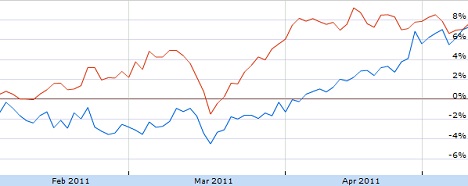May 11, 2011 | In: Energy
Transocean Limited Vs. Noble Corporation (RIG vs NE)
I used to take the public transit last year, and sometimes, yo do actually get to overhear some interesting conversations. One of these conversations was between 2 university students, apparently both were taking an investment course, and one of them was discussing his professor’s theory with the other. Here’s the professor theory: “If there are two stocks that are similar (same industry, same markets, etc…), and if one of them is going down while the other is going up, then you should buy the one going down, and sell the one going up, because such stocks should move in harmony (when one goes up, the other goes up as well, and vice versa).” The professor apparently then gave an example about PepsiCo, Inc (NYSE: PEP) and The Coca-Cola Company (NYSE: KO). Let’s take a look at these 2 stocks in the same chart to see if that professor’s theory is correct:

As you can clearly see, PEP and KO diverged in February, where PEP started to move up while KO started to move down, but in March, PEP dropped significantly, while KO dropped only slightly, and, immediately after this drop, both KO and PEP started to move up, with KO outperforming PEP, until the converged again in April. In this case buying a stock is not rocket science, any informed investor should have bought KO when it started to go down while PEP was moving up.
Now, after I exposed this theory, which appears to apply for PEP and KO, let’ see if it applies for RIG and NE, theoretically, it should, since both RIG and NE are in the same business (they both offers services for offshore drilling, including building platforms). Here’s the comparative performance chart:

It’s obvious to see that the two stocks are moving in harmony. However, you can notice that they have started diverging by mid of April, where RIG has started to drop considerably more since. What does that mean? It means that any investors with even a half a brain should start buying RIG, it’s almost a sure bet that the stock will go up (unless something insane happens in the oil services industry).
To summarize, from the chart above, we can see that RIG is undervalued by at least 10%, and it can easily go up by a 5% in the next week or two, and probably maybe meet NE somewhere in the middle.

